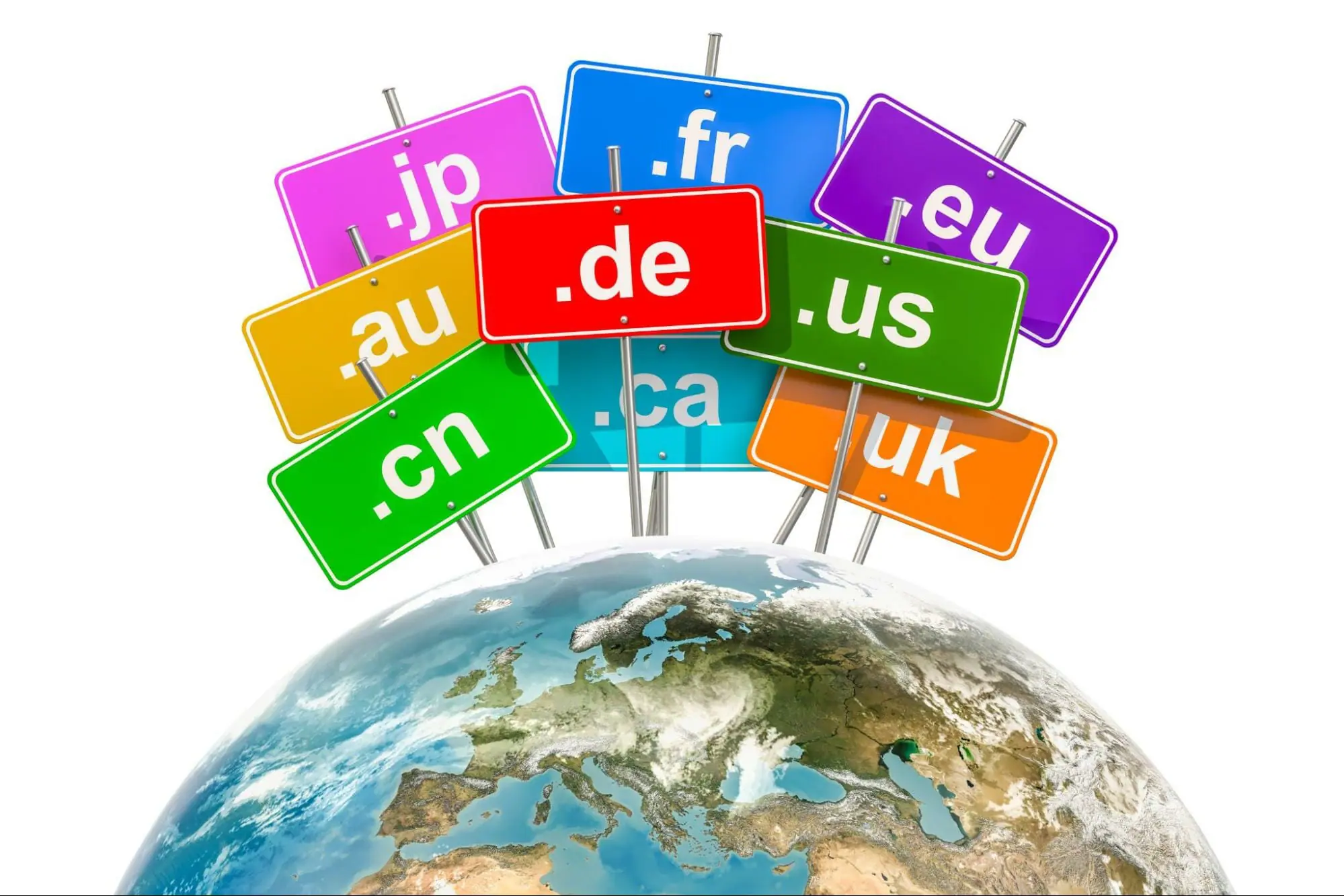Understanding ccTLDs: Country Code Top-Level Domains
We’re all familiar with the usual domain name extensions: .com, .net, .org, .gov—the list goes on. But you may have noticed that some sites use shorter, less common extensions, like .de, .cn, or .ru. These are called ccTLDs, or country code top-level domains.
What is a domain extension that is a ccTLD’s purpose? Think of it like a digital passport that tells the world where a website is from. It’s a type of top level domain (TLD) specifically designated for a particular country or a geographic territory. These country code TLDs are represented by a two-letter TLD extension, which is derived from the country names. For example, .us is the ccTLD for the United States, .uk for the United Kingdom, and .jp for Japan.
If you use a ccTLD, it won’t limit your site from displaying outside your country, but it can help you connect with a local audience. They can also boost your search engine optimization, or SEO efforts, and build trust with your visitors. But before you rush and start the ccTLD registry process for your website, there are some things you need to know.
In this article, we’ll explain what country TLDs are, why they matter, and whether a ccTLD is right for your site.
What are ccTLDs?
To understand ccTLDs, let’s start with a quick review of top-level domains, or TLDs. What is a top-level domain? The TLD is the last part of a web address following the final period. For example, if your pizza parlor’s website is called ultimatepizza.com, “.com” is the top-level domain.
There are two types of TLDs that most small business and individuals use:
- Generic top-level domains (gTLDs) – These generic TLDs are not associated with any specific country, organization, or region. They include the most common domain extensions, like .com, .net, .org, and .info. A generic top-level domain is open to anyone who wants to use one, regardless of their location or purpose.
- Country code top-level domains (ccTLDs) – ccTLDs are TLDs that are assigned to a specific country or region based on the ISO 3166-1 alpha-2 country codes. For example, .us is the ccTLD for the United States, .uk is the ccTLD for the United Kingdom, and .de is the ccTLD for Germany.
How ccTLDs differ from gTLDs
Both ccTLDs and gTLDs are types of top-level domains, but they have some key differences. These differences reflect the specific purposes and policies associated with each type of TLD, impacting who can register them and how they are used on the internet.
gTLDs (Generic Top-Level Domains)
- Definition: gTLDs are “generic TLDs” and are open domain extensions not tied to a geographical region or country.
- Registration: Anyone can register a domain name under a gTLD, regardless of their location or purpose.
ccTLDs (Country Code Top-Level Domains)
- Definition: ccTLDs are country-specific domain extensions, assigned to a country or region based on their country codes.
- Registration: Some ccTLDs have restrictions on who can register a domain name under them, such as proof of residency or local presence.
Popular ccTLDs around the world
Which are the most popular ccTLDs in the world? Here’s a brief list of some of the ccTLDs you’re most likely to encounter in the wild:
- United States – .us
- United Kingdom – .uk
- Germany – .de
- China – .cn
- Australia – .au
- Canada – .ca
- France – .fr
- India – .in
- Japan – .jp
- Brazil – .br
- Italy – .it
- Netherlands – .nl
- Russia – .ru
- Spain – .es
- Mexico – .mx
- South Korea – .kr
Other notable ccTLDs
The British Indian Ocean Territory’s ccTLD .io, has become widely popular, especially among tech startups and the gaming industry. The domain is associated with input/output operations, making it appealing to technology companies. Its adoption has surged despite the small population of the territory.
Tuvalu (.tv) a small island nation in the Pacific Ocean. This domain is highly sought after by television and video content websites due to its association with the term “TV.” The revenue generated from .tv domain registrations significantly contributes to Tuvalu’s economy.
The Federated States of Micronesia (.fm), an island nation in the Western Pacific. It is popular among radio stations and music streaming services because of its connection to “FM radio.” The .fm domain offers a unique branding opportunity for audio content providers.
The Cocos (Keeling) Islands (.cc), is a small Australian territory that most Australians do not even know of. It has gained popularity due to its simplicity and versatility, often used as a generic domain extension. The .cc domain is easy to remember and is used by a variety of businesses and individuals worldwide.
Montenegro (.me) and their ccTLD has been marketed as a personal and memorable domain name for individuals and businesses. It is often used for personal blogs, resumes, and social media profiles due to its association with the word “me.” The .me domain provides a unique way for users to personalize their online presence.
Advantages of using ccTLDs
ccTLDs aren’t just a way of saying you’re proud of where you live. ccTLDs also have practical benefits for businesses that want to reach a regional audience. Using a country domain can help you:
- Enhance local SEO – ccTLDs show search engines that your site is relevant for a specific country so that it ranks higher for local searches.
- Build trust with local audiences – Using a ccTLD shows potential customers that you have a local presence. A country code domain can attract and retain loyal customers who prefer to shop local.
- Meet country-specific legal and regulatory requirements – Country TLDs are primarily used by websites that want to emphasize their connection to a specific country. A ccTLD may help you comply with regulations for online activities in a specific region, such as data protection, taxation, or content restrictions. For example, using an .eu domain extension could help signal that you’re compliant with the General Data Protection Regulation (GDPR) for websites operating in the European Union.
- Demonstrate cultural sensitivity – Using a country domain can also allow you to create a localized version of your website that matches the culture and language of your target audience. You can make changes to the lexicon, currency, date format, spelling, tone, and more.
Things to consider before registering a ccTLD
Using a ccTLD can be a smart strategy, but there are a few factors to keep in mind before you get started:
- Availability and eligibility criteria – Not all ccTLDs are available for anyone to register. Some ccTLDs have strict eligibility criteria that require you to have a physical presence, a local contact, or a valid trademark in the country or region.
- Cost of registration and renewal – The cost of a ccTLD can vary widely. Some ccTLDs are more expensive than others, some are free (like .tk, as noted above), and some may have additional fees or taxes.
- Local hosting requirements – Some ccTLDs require you to host your website on a local server in the country or region of the domain extension. This can affect the speed, performance, and security of your website.
- Managing multiple domains – If you choose to expand your current website with a separate domain using a ccTLD, keep in mind that search engines will treat it as a new site. In some cases it may be simpler to create a subdomain or subdirectory on your existing site rather than managing a new site with a ccTLD.
Register your ccTLD with Name.com today
Choosing between gTLDs and ccTLDs depends largely on your goals and target market. If you want to reach a global audience and have the most options for geotargeted advertising, gTLDs may be best. If you want to reach a local audience, a ccTLD may be more suitable for you.
Are you ready to buy a domain name? Whichever route you choose, Name.com can help you land a domain name that’s a perfect fit. Start by using our domain name search tool to see what’s available and get inspired by our suggestions. Once you’ve found your ideal domain name, register it with us in minutes and get started with the best web hosting options and exceptional customer service.
With Name.com, creating your site is a snap.
Sources:
International Organization for Standardization. ISO 3166: Country codes. https://www.iso.org/iso-3166-country-codes.html
Statista. Leading country code top level domains (ccTLD) as of January 2023, by number of registered domains. https://www.statista.com/statistics/266721/sales-of-cc-top-level-domains/
Search Engine Journal. Does domain extension affect SEO? Google’s John Mueller explains. https://www.searchenginejournal.com/does-domain-extension-affect-seo/431956/
Search Engine Journal. Subdomain, subdirectory & ccTLD: Which one should you use? https://www.searchenginejournal.com/subdomain-subdirectory-cctld-which-one-should-you-use/448277/
Technopedia. Top-level domain. https://www.techopedia.com/definition/1348/top-level-domain-tld

